An Analysis of Systems and Field Theories in Group Work (CAS102)
VerifiedAdded on 2022/11/09
|7
|1616
|185
Essay
AI Summary
This essay delves into two prominent theories in group work: systems theory and field theory. It begins by introducing the fundamental concepts of group dynamics and the challenges groups face. The essay then provides an overview of systems theory, which emphasizes the interconnectedness of group members and the importance of understanding the group as a whole, considering the environment and the individual members. Next, it explains Kurt Lewin's field theory, which views a group as an evolving entity influenced by opposing forces and emphasizes the roles, duties, and behaviors of the group members. The essay highlights the similarities between the two theories, such as the presence of barriers and developmental stages. It further distinguishes the theories, noting that field theory focuses on forces affecting group work, while systems theory explores human behavior through interrelated systems. The essay concludes by emphasizing the importance of these theories as tools for understanding and improving group processes within the framework of social work.
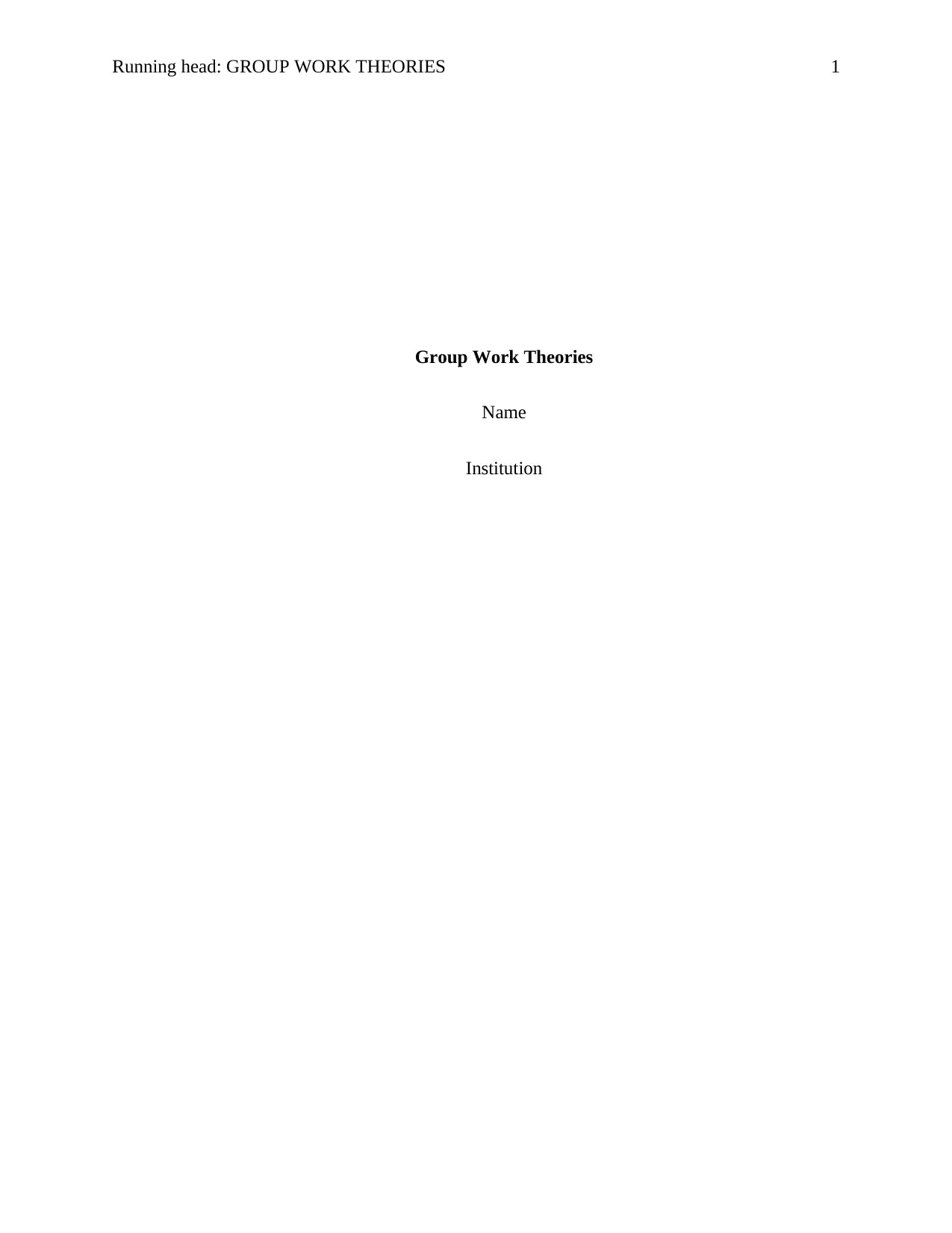
Running head: GROUP WORK THEORIES 1
Group Work Theories
Name
Institution
Group Work Theories
Name
Institution
Paraphrase This Document
Need a fresh take? Get an instant paraphrase of this document with our AI Paraphraser
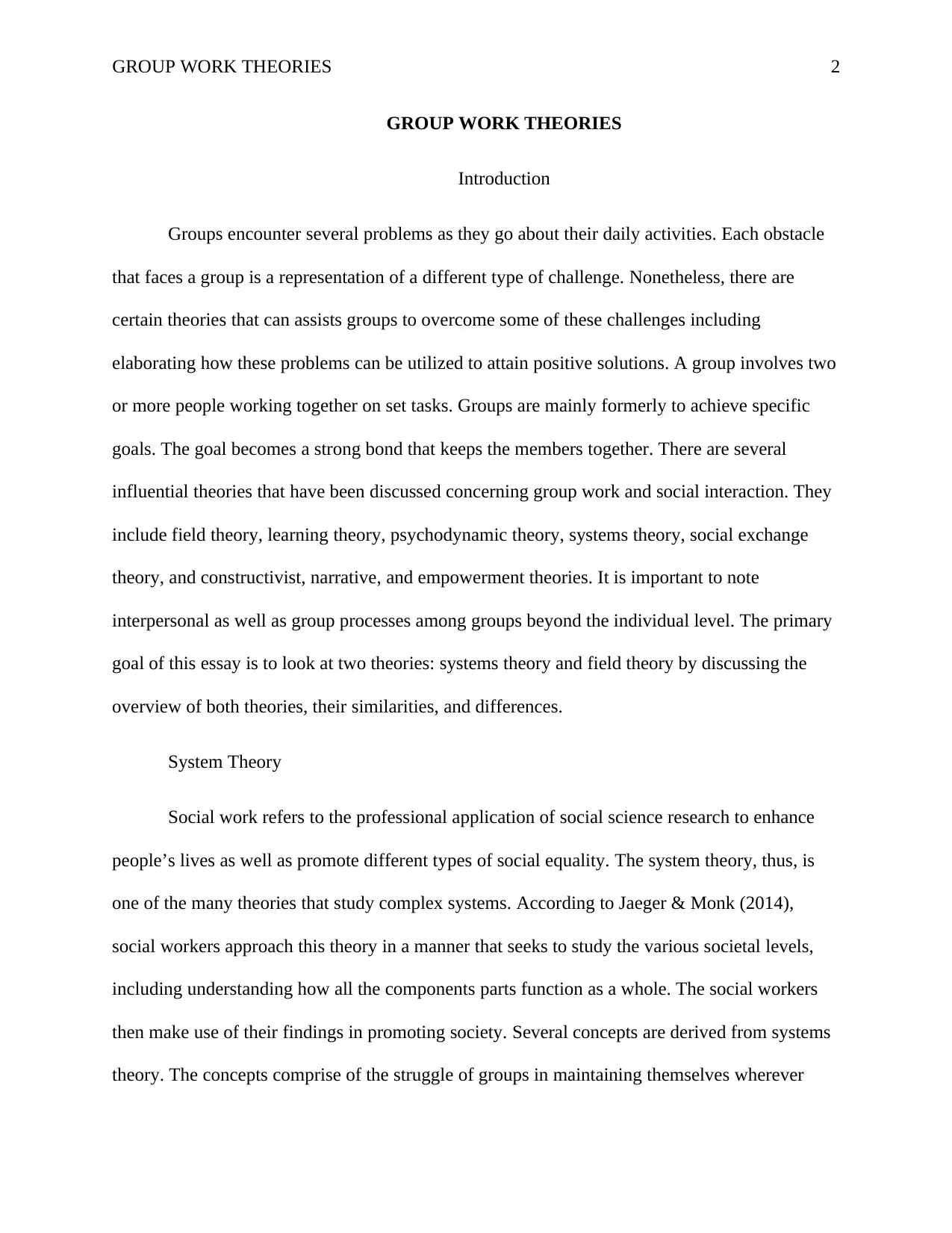
GROUP WORK THEORIES 2
GROUP WORK THEORIES
Introduction
Groups encounter several problems as they go about their daily activities. Each obstacle
that faces a group is a representation of a different type of challenge. Nonetheless, there are
certain theories that can assists groups to overcome some of these challenges including
elaborating how these problems can be utilized to attain positive solutions. A group involves two
or more people working together on set tasks. Groups are mainly formerly to achieve specific
goals. The goal becomes a strong bond that keeps the members together. There are several
influential theories that have been discussed concerning group work and social interaction. They
include field theory, learning theory, psychodynamic theory, systems theory, social exchange
theory, and constructivist, narrative, and empowerment theories. It is important to note
interpersonal as well as group processes among groups beyond the individual level. The primary
goal of this essay is to look at two theories: systems theory and field theory by discussing the
overview of both theories, their similarities, and differences.
System Theory
Social work refers to the professional application of social science research to enhance
people’s lives as well as promote different types of social equality. The system theory, thus, is
one of the many theories that study complex systems. According to Jaeger & Monk (2014),
social workers approach this theory in a manner that seeks to study the various societal levels,
including understanding how all the components parts function as a whole. The social workers
then make use of their findings in promoting society. Several concepts are derived from systems
theory. The concepts comprise of the struggle of groups in maintaining themselves wherever
GROUP WORK THEORIES
Introduction
Groups encounter several problems as they go about their daily activities. Each obstacle
that faces a group is a representation of a different type of challenge. Nonetheless, there are
certain theories that can assists groups to overcome some of these challenges including
elaborating how these problems can be utilized to attain positive solutions. A group involves two
or more people working together on set tasks. Groups are mainly formerly to achieve specific
goals. The goal becomes a strong bond that keeps the members together. There are several
influential theories that have been discussed concerning group work and social interaction. They
include field theory, learning theory, psychodynamic theory, systems theory, social exchange
theory, and constructivist, narrative, and empowerment theories. It is important to note
interpersonal as well as group processes among groups beyond the individual level. The primary
goal of this essay is to look at two theories: systems theory and field theory by discussing the
overview of both theories, their similarities, and differences.
System Theory
Social work refers to the professional application of social science research to enhance
people’s lives as well as promote different types of social equality. The system theory, thus, is
one of the many theories that study complex systems. According to Jaeger & Monk (2014),
social workers approach this theory in a manner that seeks to study the various societal levels,
including understanding how all the components parts function as a whole. The social workers
then make use of their findings in promoting society. Several concepts are derived from systems
theory. The concepts comprise of the struggle of groups in maintaining themselves wherever
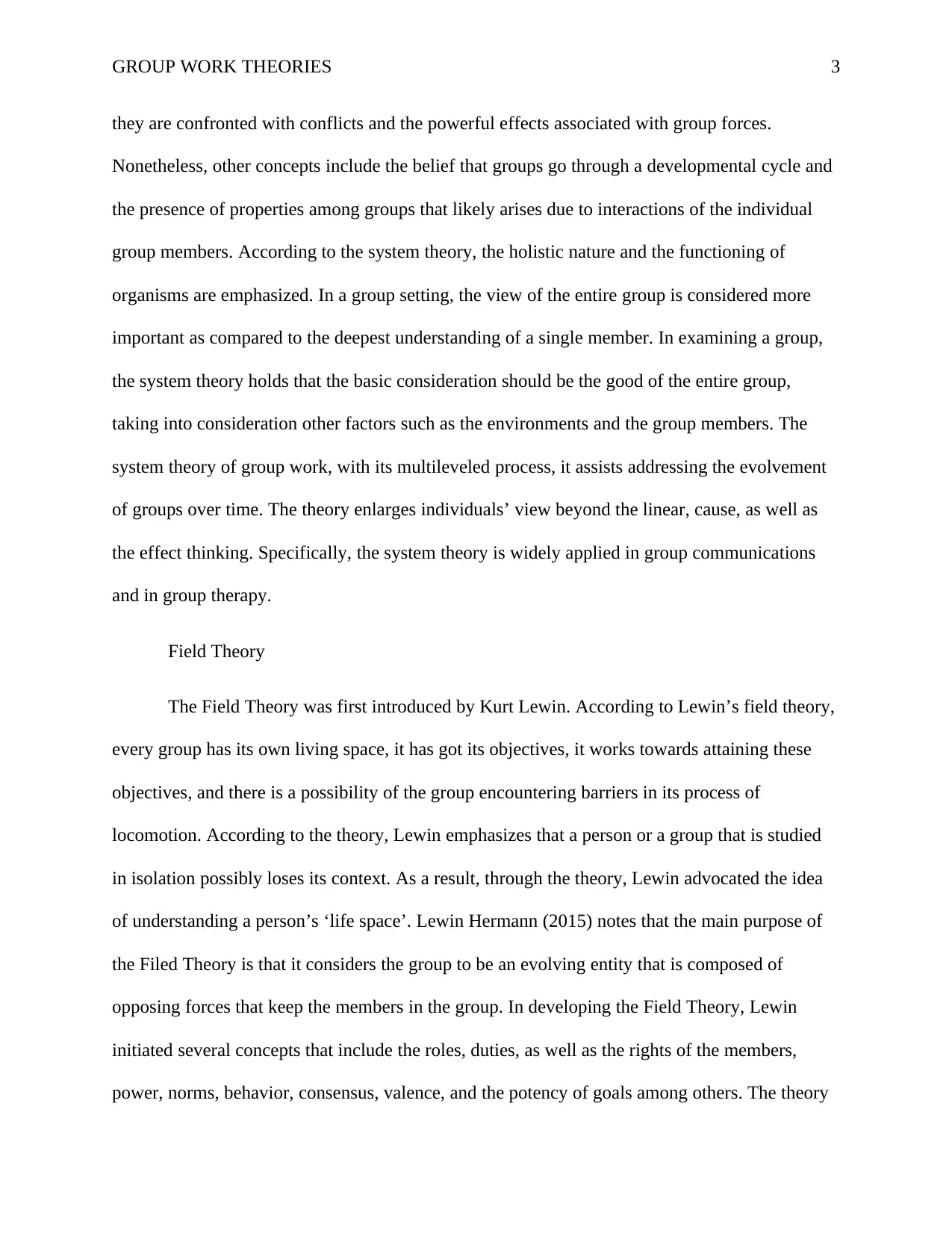
GROUP WORK THEORIES 3
they are confronted with conflicts and the powerful effects associated with group forces.
Nonetheless, other concepts include the belief that groups go through a developmental cycle and
the presence of properties among groups that likely arises due to interactions of the individual
group members. According to the system theory, the holistic nature and the functioning of
organisms are emphasized. In a group setting, the view of the entire group is considered more
important as compared to the deepest understanding of a single member. In examining a group,
the system theory holds that the basic consideration should be the good of the entire group,
taking into consideration other factors such as the environments and the group members. The
system theory of group work, with its multileveled process, it assists addressing the evolvement
of groups over time. The theory enlarges individuals’ view beyond the linear, cause, as well as
the effect thinking. Specifically, the system theory is widely applied in group communications
and in group therapy.
Field Theory
The Field Theory was first introduced by Kurt Lewin. According to Lewin’s field theory,
every group has its own living space, it has got its objectives, it works towards attaining these
objectives, and there is a possibility of the group encountering barriers in its process of
locomotion. According to the theory, Lewin emphasizes that a person or a group that is studied
in isolation possibly loses its context. As a result, through the theory, Lewin advocated the idea
of understanding a person’s ‘life space’. Lewin Hermann (2015) notes that the main purpose of
the Filed Theory is that it considers the group to be an evolving entity that is composed of
opposing forces that keep the members in the group. In developing the Field Theory, Lewin
initiated several concepts that include the roles, duties, as well as the rights of the members,
power, norms, behavior, consensus, valence, and the potency of goals among others. The theory
they are confronted with conflicts and the powerful effects associated with group forces.
Nonetheless, other concepts include the belief that groups go through a developmental cycle and
the presence of properties among groups that likely arises due to interactions of the individual
group members. According to the system theory, the holistic nature and the functioning of
organisms are emphasized. In a group setting, the view of the entire group is considered more
important as compared to the deepest understanding of a single member. In examining a group,
the system theory holds that the basic consideration should be the good of the entire group,
taking into consideration other factors such as the environments and the group members. The
system theory of group work, with its multileveled process, it assists addressing the evolvement
of groups over time. The theory enlarges individuals’ view beyond the linear, cause, as well as
the effect thinking. Specifically, the system theory is widely applied in group communications
and in group therapy.
Field Theory
The Field Theory was first introduced by Kurt Lewin. According to Lewin’s field theory,
every group has its own living space, it has got its objectives, it works towards attaining these
objectives, and there is a possibility of the group encountering barriers in its process of
locomotion. According to the theory, Lewin emphasizes that a person or a group that is studied
in isolation possibly loses its context. As a result, through the theory, Lewin advocated the idea
of understanding a person’s ‘life space’. Lewin Hermann (2015) notes that the main purpose of
the Filed Theory is that it considers the group to be an evolving entity that is composed of
opposing forces that keep the members in the group. In developing the Field Theory, Lewin
initiated several concepts that include the roles, duties, as well as the rights of the members,
power, norms, behavior, consensus, valence, and the potency of goals among others. The theory
⊘ This is a preview!⊘
Do you want full access?
Subscribe today to unlock all pages.

Trusted by 1+ million students worldwide
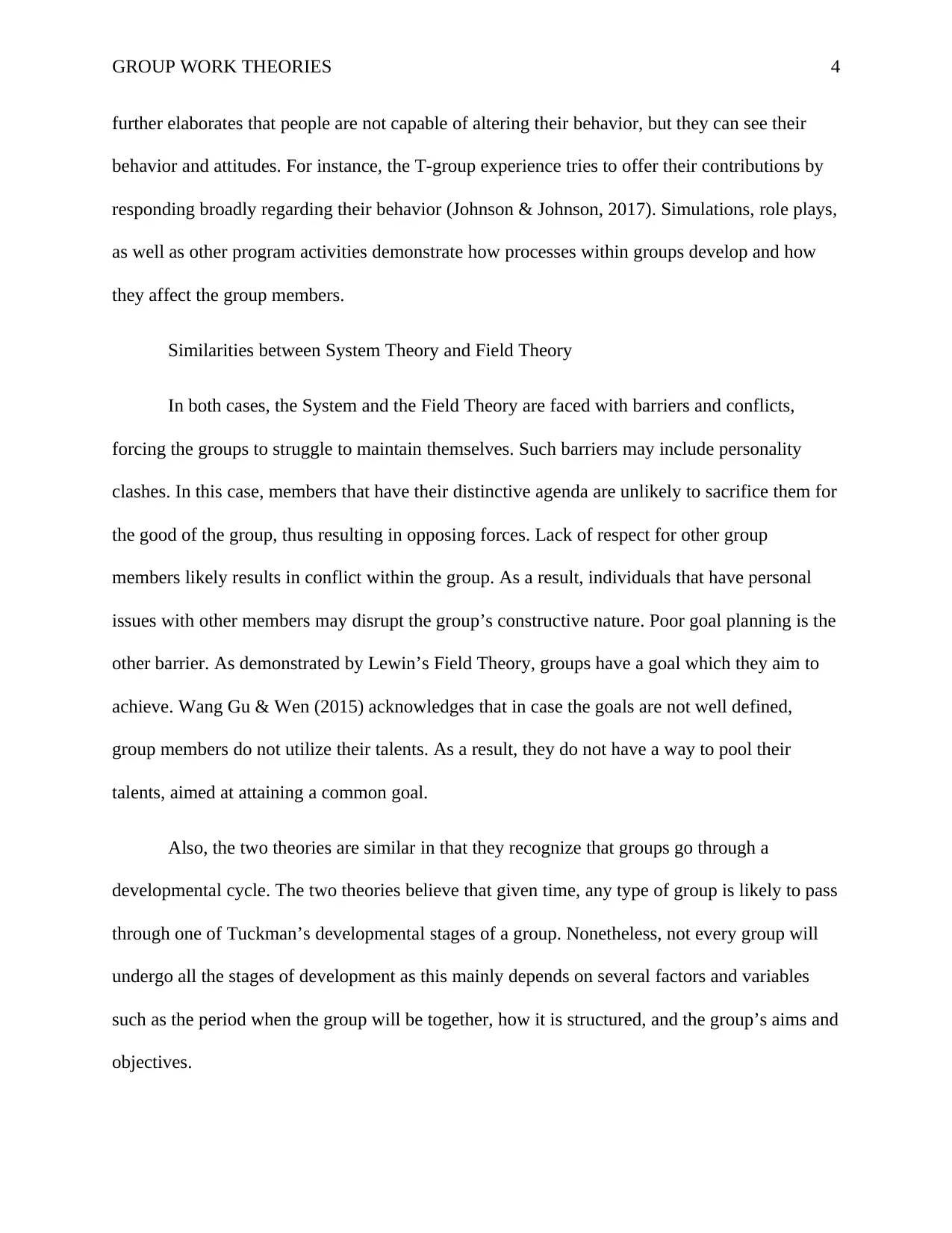
GROUP WORK THEORIES 4
further elaborates that people are not capable of altering their behavior, but they can see their
behavior and attitudes. For instance, the T-group experience tries to offer their contributions by
responding broadly regarding their behavior (Johnson & Johnson, 2017). Simulations, role plays,
as well as other program activities demonstrate how processes within groups develop and how
they affect the group members.
Similarities between System Theory and Field Theory
In both cases, the System and the Field Theory are faced with barriers and conflicts,
forcing the groups to struggle to maintain themselves. Such barriers may include personality
clashes. In this case, members that have their distinctive agenda are unlikely to sacrifice them for
the good of the group, thus resulting in opposing forces. Lack of respect for other group
members likely results in conflict within the group. As a result, individuals that have personal
issues with other members may disrupt the group’s constructive nature. Poor goal planning is the
other barrier. As demonstrated by Lewin’s Field Theory, groups have a goal which they aim to
achieve. Wang Gu & Wen (2015) acknowledges that in case the goals are not well defined,
group members do not utilize their talents. As a result, they do not have a way to pool their
talents, aimed at attaining a common goal.
Also, the two theories are similar in that they recognize that groups go through a
developmental cycle. The two theories believe that given time, any type of group is likely to pass
through one of Tuckman’s developmental stages of a group. Nonetheless, not every group will
undergo all the stages of development as this mainly depends on several factors and variables
such as the period when the group will be together, how it is structured, and the group’s aims and
objectives.
further elaborates that people are not capable of altering their behavior, but they can see their
behavior and attitudes. For instance, the T-group experience tries to offer their contributions by
responding broadly regarding their behavior (Johnson & Johnson, 2017). Simulations, role plays,
as well as other program activities demonstrate how processes within groups develop and how
they affect the group members.
Similarities between System Theory and Field Theory
In both cases, the System and the Field Theory are faced with barriers and conflicts,
forcing the groups to struggle to maintain themselves. Such barriers may include personality
clashes. In this case, members that have their distinctive agenda are unlikely to sacrifice them for
the good of the group, thus resulting in opposing forces. Lack of respect for other group
members likely results in conflict within the group. As a result, individuals that have personal
issues with other members may disrupt the group’s constructive nature. Poor goal planning is the
other barrier. As demonstrated by Lewin’s Field Theory, groups have a goal which they aim to
achieve. Wang Gu & Wen (2015) acknowledges that in case the goals are not well defined,
group members do not utilize their talents. As a result, they do not have a way to pool their
talents, aimed at attaining a common goal.
Also, the two theories are similar in that they recognize that groups go through a
developmental cycle. The two theories believe that given time, any type of group is likely to pass
through one of Tuckman’s developmental stages of a group. Nonetheless, not every group will
undergo all the stages of development as this mainly depends on several factors and variables
such as the period when the group will be together, how it is structured, and the group’s aims and
objectives.
Paraphrase This Document
Need a fresh take? Get an instant paraphrase of this document with our AI Paraphraser
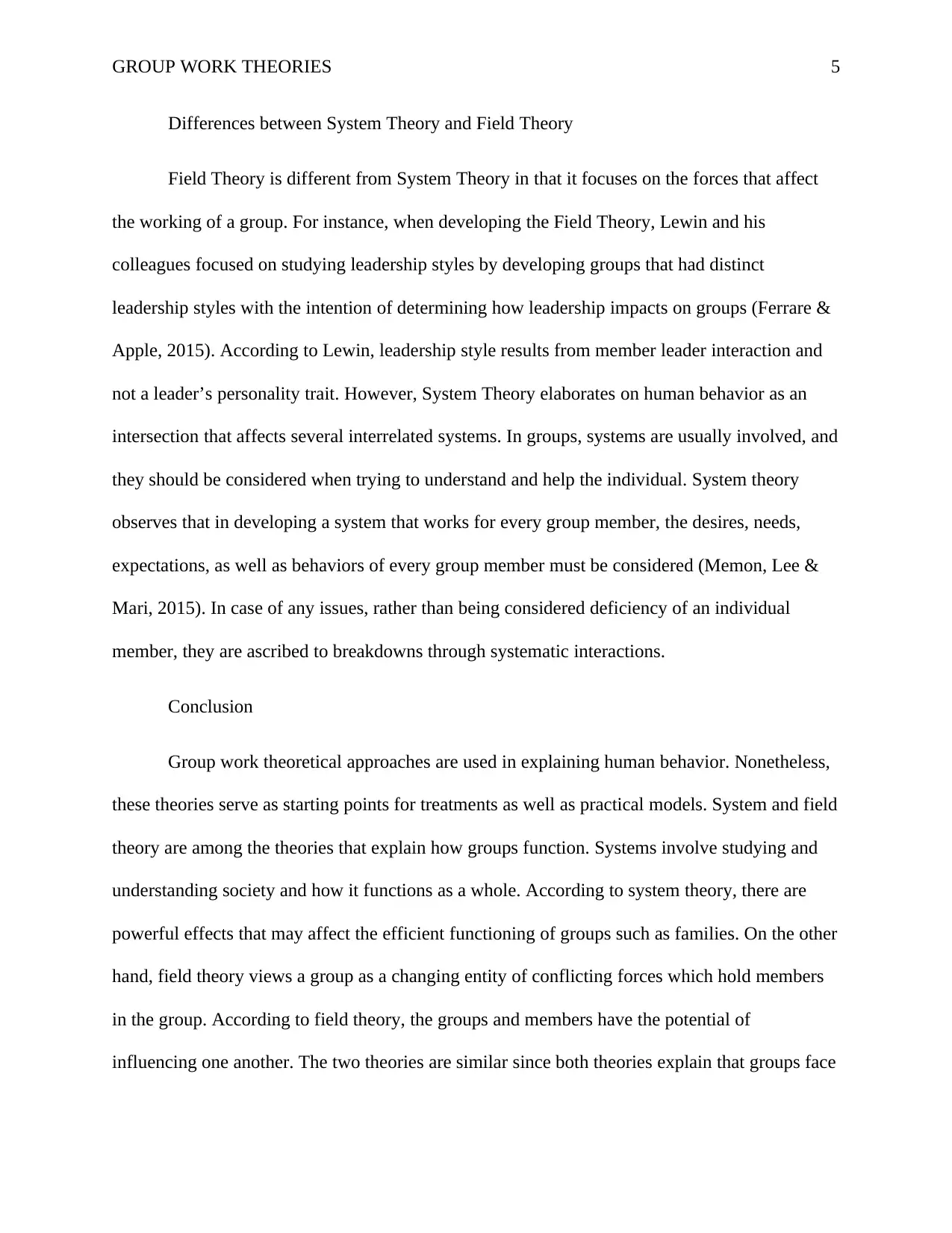
GROUP WORK THEORIES 5
Differences between System Theory and Field Theory
Field Theory is different from System Theory in that it focuses on the forces that affect
the working of a group. For instance, when developing the Field Theory, Lewin and his
colleagues focused on studying leadership styles by developing groups that had distinct
leadership styles with the intention of determining how leadership impacts on groups (Ferrare &
Apple, 2015). According to Lewin, leadership style results from member leader interaction and
not a leader’s personality trait. However, System Theory elaborates on human behavior as an
intersection that affects several interrelated systems. In groups, systems are usually involved, and
they should be considered when trying to understand and help the individual. System theory
observes that in developing a system that works for every group member, the desires, needs,
expectations, as well as behaviors of every group member must be considered (Memon, Lee &
Mari, 2015). In case of any issues, rather than being considered deficiency of an individual
member, they are ascribed to breakdowns through systematic interactions.
Conclusion
Group work theoretical approaches are used in explaining human behavior. Nonetheless,
these theories serve as starting points for treatments as well as practical models. System and field
theory are among the theories that explain how groups function. Systems involve studying and
understanding society and how it functions as a whole. According to system theory, there are
powerful effects that may affect the efficient functioning of groups such as families. On the other
hand, field theory views a group as a changing entity of conflicting forces which hold members
in the group. According to field theory, the groups and members have the potential of
influencing one another. The two theories are similar since both theories explain that groups face
Differences between System Theory and Field Theory
Field Theory is different from System Theory in that it focuses on the forces that affect
the working of a group. For instance, when developing the Field Theory, Lewin and his
colleagues focused on studying leadership styles by developing groups that had distinct
leadership styles with the intention of determining how leadership impacts on groups (Ferrare &
Apple, 2015). According to Lewin, leadership style results from member leader interaction and
not a leader’s personality trait. However, System Theory elaborates on human behavior as an
intersection that affects several interrelated systems. In groups, systems are usually involved, and
they should be considered when trying to understand and help the individual. System theory
observes that in developing a system that works for every group member, the desires, needs,
expectations, as well as behaviors of every group member must be considered (Memon, Lee &
Mari, 2015). In case of any issues, rather than being considered deficiency of an individual
member, they are ascribed to breakdowns through systematic interactions.
Conclusion
Group work theoretical approaches are used in explaining human behavior. Nonetheless,
these theories serve as starting points for treatments as well as practical models. System and field
theory are among the theories that explain how groups function. Systems involve studying and
understanding society and how it functions as a whole. According to system theory, there are
powerful effects that may affect the efficient functioning of groups such as families. On the other
hand, field theory views a group as a changing entity of conflicting forces which hold members
in the group. According to field theory, the groups and members have the potential of
influencing one another. The two theories are similar since both theories explain that groups face

GROUP WORK THEORIES 6
struggles which they try to confront to maintain their operations. Another similarity is both
theories have stages of developmental cycles.
struggles which they try to confront to maintain their operations. Another similarity is both
theories have stages of developmental cycles.
⊘ This is a preview!⊘
Do you want full access?
Subscribe today to unlock all pages.

Trusted by 1+ million students worldwide
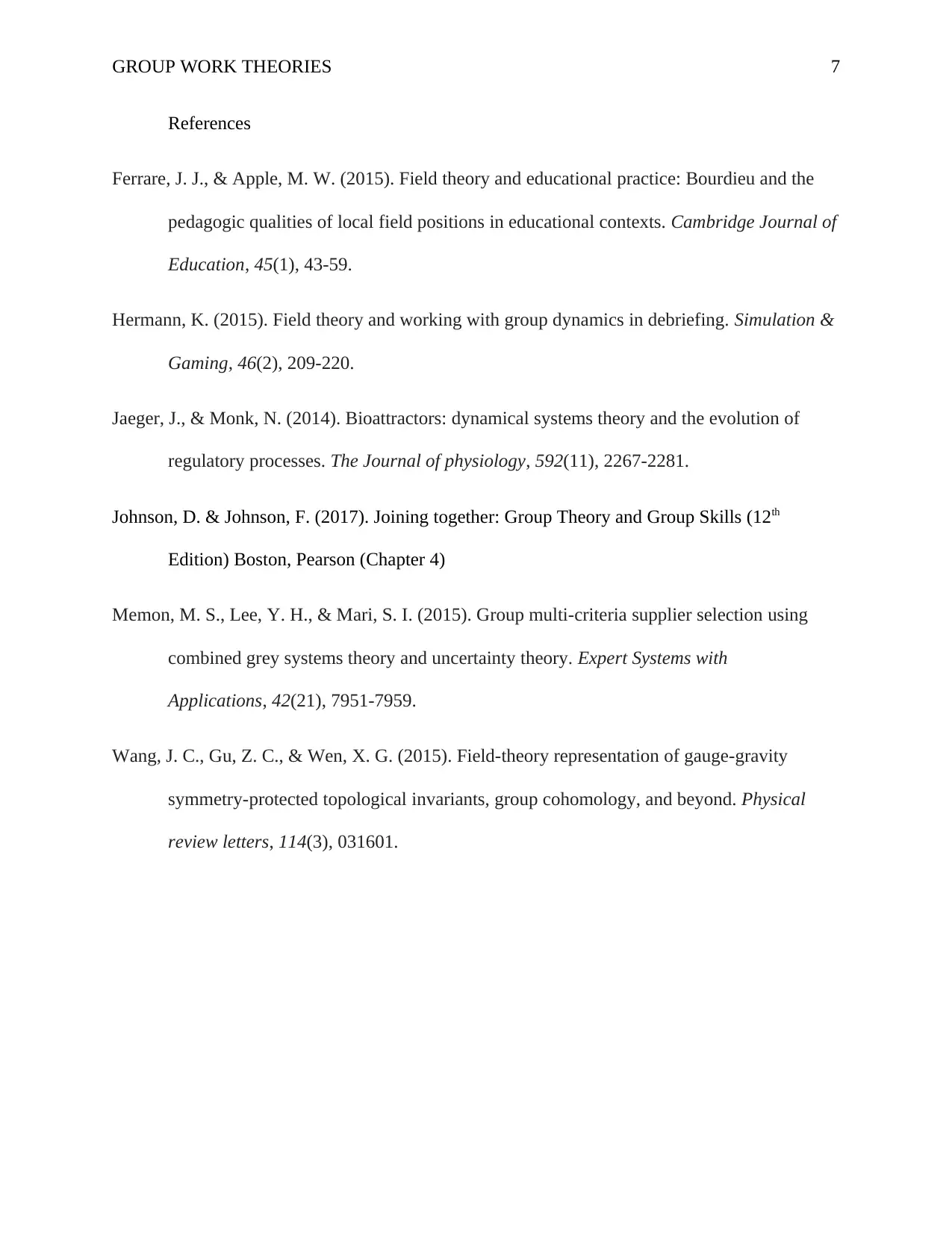
GROUP WORK THEORIES 7
References
Ferrare, J. J., & Apple, M. W. (2015). Field theory and educational practice: Bourdieu and the
pedagogic qualities of local field positions in educational contexts. Cambridge Journal of
Education, 45(1), 43-59.
Hermann, K. (2015). Field theory and working with group dynamics in debriefing. Simulation &
Gaming, 46(2), 209-220.
Jaeger, J., & Monk, N. (2014). Bioattractors: dynamical systems theory and the evolution of
regulatory processes. The Journal of physiology, 592(11), 2267-2281.
Johnson, D. & Johnson, F. (2017). Joining together: Group Theory and Group Skills (12th
Edition) Boston, Pearson (Chapter 4)
Memon, M. S., Lee, Y. H., & Mari, S. I. (2015). Group multi-criteria supplier selection using
combined grey systems theory and uncertainty theory. Expert Systems with
Applications, 42(21), 7951-7959.
Wang, J. C., Gu, Z. C., & Wen, X. G. (2015). Field-theory representation of gauge-gravity
symmetry-protected topological invariants, group cohomology, and beyond. Physical
review letters, 114(3), 031601.
References
Ferrare, J. J., & Apple, M. W. (2015). Field theory and educational practice: Bourdieu and the
pedagogic qualities of local field positions in educational contexts. Cambridge Journal of
Education, 45(1), 43-59.
Hermann, K. (2015). Field theory and working with group dynamics in debriefing. Simulation &
Gaming, 46(2), 209-220.
Jaeger, J., & Monk, N. (2014). Bioattractors: dynamical systems theory and the evolution of
regulatory processes. The Journal of physiology, 592(11), 2267-2281.
Johnson, D. & Johnson, F. (2017). Joining together: Group Theory and Group Skills (12th
Edition) Boston, Pearson (Chapter 4)
Memon, M. S., Lee, Y. H., & Mari, S. I. (2015). Group multi-criteria supplier selection using
combined grey systems theory and uncertainty theory. Expert Systems with
Applications, 42(21), 7951-7959.
Wang, J. C., Gu, Z. C., & Wen, X. G. (2015). Field-theory representation of gauge-gravity
symmetry-protected topological invariants, group cohomology, and beyond. Physical
review letters, 114(3), 031601.
1 out of 7
Related Documents
Your All-in-One AI-Powered Toolkit for Academic Success.
+13062052269
info@desklib.com
Available 24*7 on WhatsApp / Email
![[object Object]](/_next/static/media/star-bottom.7253800d.svg)
Unlock your academic potential
Copyright © 2020–2025 A2Z Services. All Rights Reserved. Developed and managed by ZUCOL.





